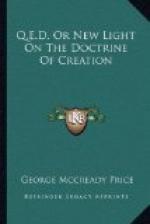Quite recently this region has been studied by Marius R. Campbell of the Washington Survey Staff (Bulletin 600), while the part in Alberta has been studied by Rollin T. Chamberlin of Chicago. Much of the vast area involved is not yet well explored; but over it all, so far as it has been fully examined, the same lithological and stratigraphical structures reappear with the persistence of a repeating decimal. And were it not for the exigencies of the theory of Successive Ages, this whole region of some five or six thousand square miles would be considered as only an ordinary example, on a rather large scale, of undisturbed horizontal stratification cut up by erosion into mountains of denudation, with of course occasional instances of minor local disturbances here and there, as would be expected over an area of this extent.
Richards and Mansfield in a recent paper describe the “Bannock Overthrust,” some 270 miles long, in Utah, Idaho, and Wyoming. The Carnegie Research recently reported a similar phenomenon about 500 miles long in northern China.
But it would be tiresome to follow these conditions around the world. We have plenty of examples, and we have them described by the foremost of living geologists. What we need to do now is to adopt a true scientific attitude of mind, a mind freed from the hypnotizing influence of the current theories, in order correctly to interpret the facts as we already have them.
How much of the earth’s crust would we have to find in this upside down order of the fossils, before we would be convinced that there must be something hopelessly wrong with this theory of Successive Ages which drives otherwise competent observers to throw away their common sense and cling desperately to a fantastic theory in the very teeth of such facts?
The science of geology as commonly taught is truly in a most astonishing condition, and doubtless presents the most peculiar mixture of fact and nonsense to be found in the whole range of our modern knowledge. In any minute study of a particular set of rocks in a definite locality, geology always follows facts and common sense; while in any general view of the world as a whole, or in any correlation of the rocks of one region with those of another region, it follows its absurd, unscientific theories. But wherever it agrees with facts and common sense, it contradicts these absurd theories; and wherever it agrees with these theories, it contradicts facts and common sense. That most educated people still believe its main thesis of a definite age for each particular kind of fossil is a sad but instructive example of the effects of mental inertia.
IV
The reader will find this matter discussed at length in the author’s “Fundamentals of Geology”; but here it will be necessary only to draw some very obvious conclusions from the five facts which we have set in opposition to the theory of Successive Ages.




